Effective learning requires the proper techniques to help students absorb and apply what they learn. Throughout history, the education sector has sought out the most efficient learning tools to make knowledge acquisition more effective and enjoyable.
As a result of that search, cognitive learning has emerged as one of the most successful study techniques.
From this informative guide, you’ll get to know more about:
- Cognitive learning in its various forms;
- Its influence on human behavior;
- Various cognitive factors in educational process;
- Some practical techniques to pump your brain in and out of class.
Let’s delve into the different cognitive learning techniques for successful learning!
Keep reading to learn more and find out how to benefit from this approach.
🧠 What Is Cognitive Learning?
We’ll start our discussion with a definition to better understand what this educational method covers.
Cognitive learning is a technique that relies on comprehending new information instead of memorizing it.
This type of learning can happen without external stimuli or immediate utilization.
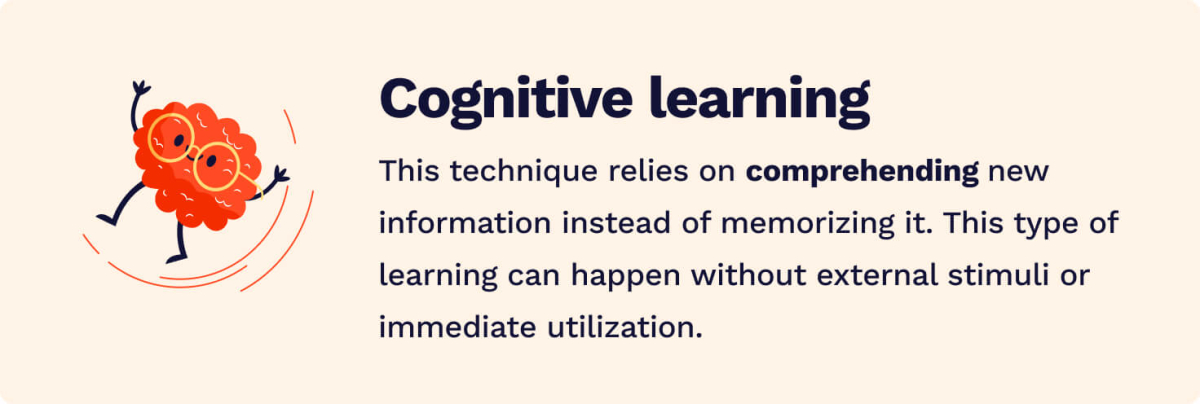
It focuses on changing a student’s knowledge base by linking new data with their past experience.
The approach centers on the student instead of external factors and prizes their involvement and the correct use of their learning abilities. Consequently, learners assimilate knowledge more efficiently and keep it for longer while developing their personalities and brains.
Benefits of Cognitive Learning
So, why is cognitive learning important?
The main advantages it offers are:
- Faster learning.
- Enhanced confidence.
- Better comprehension.
- Improved problem-solving skills.
📖 Cognitive Learning Theory
Cognitive learning theory was developed by Jean Piaget, a psychologist who researched human learning in the 1930s.
At that time, the behaviorist school of psychology was at its peak. Its approach focused on the human behaviors that psychologists could observe externally.
Piaget’s contemporaries believed that a person’s interactions with external events and circumstances predominantly dictated their behavior.
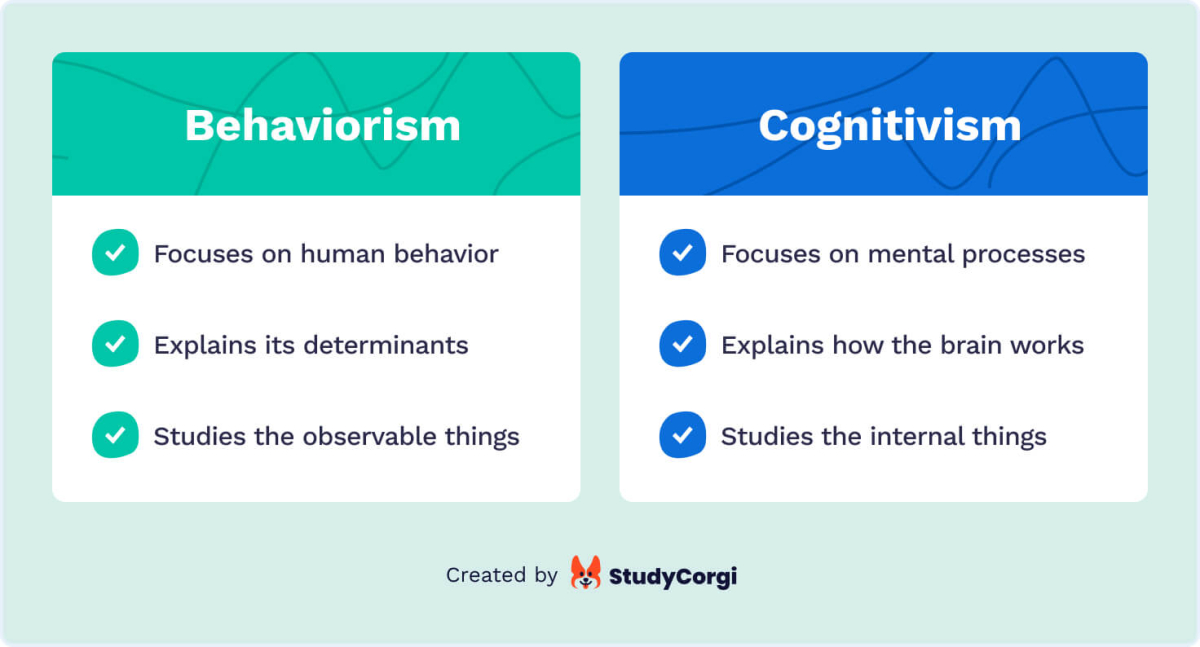
Piaget’s approach focused on the internal processes around a student’s memory and academic information. His theory thus contradicted his generation’s mainstream beliefs, which focused on examining a learner’s conduct.
Piaget focused on the importance of the internal processes tied to our personal character development.
His learning theory explains how our brains take in, store, and retrieve data during learning. It also prioritizes developing learners’ problem-solving skills through experience while solving problems.
According to Piaget’s theory, students need the following 3 elements to learn well:
- New stimuli
- Responses
The cognitive learning approach assumes that learners assimilate, interpret, store, and retrieve new data in a natural way. Like computers, their minds process and react to new data. Therefore, educators should understand the processes in their students’ brains to encourage the correct behavior for effective learning.
Piaget’s Achievements
Jean Piaget worked with young children and infants. His experience with these young people helped him understand how the human brain processes information. Piaget zeroed in on our internal mental processes as key behavior determinants.
Piaget’s main achievements related to cognitive learning are:
- Systematization of children’s development stages (sensorimotor, pre-operational, concrete operational, formal operational).
- Understanding how children learn by doing instead of listening or reading about new skills.
- Discovering distinct learning approaches that children have apart from adults.
- Explaining the role of creativity and imagination in children’s learning activities.
- Understanding how children learn by mistakes.
According to cognitive learning approach, knowledge centers on processing what things are and aren’t. This processing can be as simple as a learner recognizing a painting to complex matters like the advantages of using technology in schools.
Many cognitive psychologists have embraced Piaget’s findings and taken them to new heights.
When describing the necessary processes for effective learning, they combine 2 realities: cognition and learning. They focus their ideas on the mind’s ability to acquire knowledge and understand things through experience, thoughts, and senses.
🎓 Cognitive Factors in Learning
Cognitive learning differs from other training approaches.
In what ways?
- First of all, it focuses on students’ internal mental processes to understand new information.
- Secondly, it relies on the mind’s potential to connect with existing ideas and deepen one’s memory and retention capacity.
This section examines the main cognitive factors in learning: comprehension, memory, and application.
Comprehension
This cognitive process happens when the human brain first encounters an external stimulus.
During the comprehension phase of learning, the mind seeks connections between new stimuli and the knowledge stored in its long-term memory.
Comprehension requires the mind to process all data accurately before understanding it correctly.
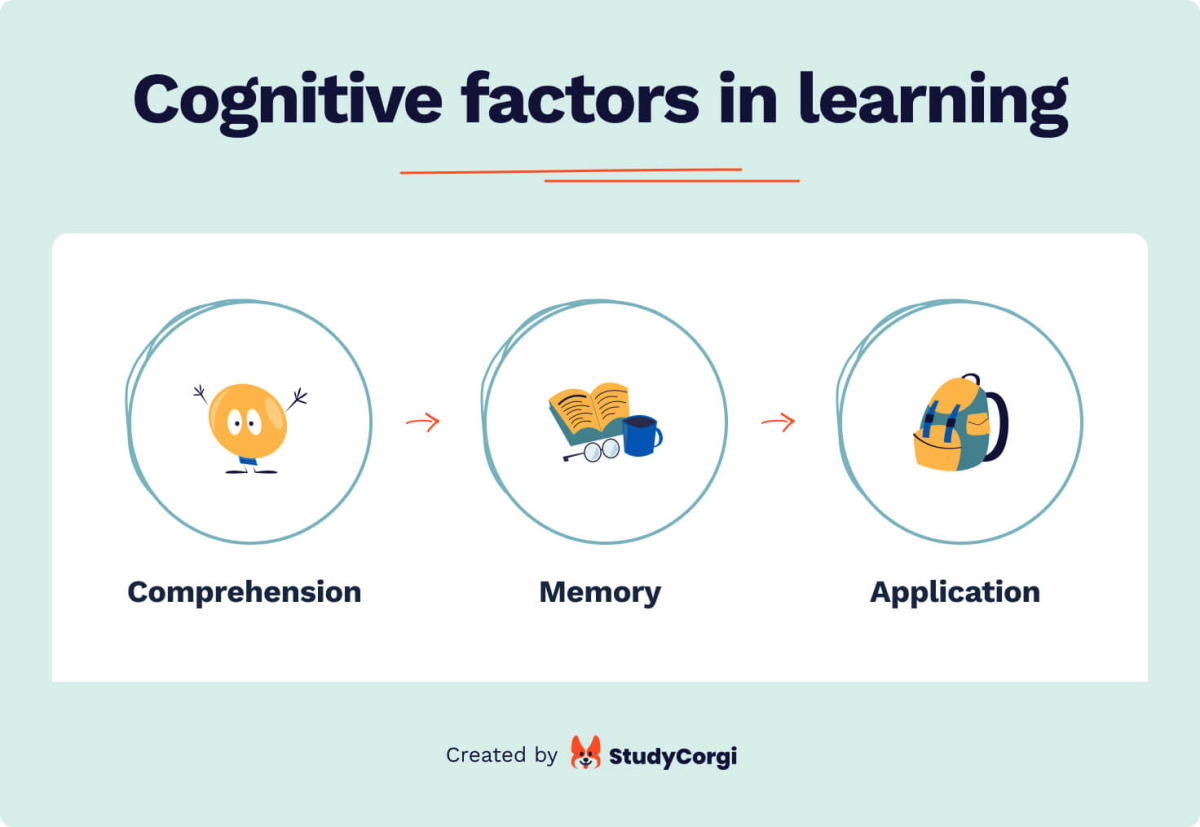
This process occurs through 3 main avenues:
- Thoughts
- Senses
- Experiences
It blends learning with the brain’s cognitive power to help the learner comprehend a concept and its meaning, as well as relate it to past experiences and find a proper place for it in their worldview.
Memory
This dimension focuses on the mind’s ability to preserve a concept or phenomenon until it records it in its long-term memory.
Cognitive learning advocates are against overloading the brain with data and instead favor integrating it in segments and from different angles.
This way, cognitive learning encourages a deeper subject understanding achieved via cognition instead of cramming. Thus, it benefits learners more because it allows them to understand facts better and store them in their long-term memory.
Application
This phase of cognitive learning is practical, unlike other educational approaches focusing on memorization.
Application allows learners space to reflect on what they have learned and relate that new data to their broader worldview.
Additionally, the application exercise helps students develop problem-solving skills to create new relationships between learned information and previous knowledge. Teachers favoring a cognitive approach give learners practical and meaningful tasks to help them solidify their knowledge base in real life.
👍 5 Benefits of Cognitive Learning
This learning concept benefits learners in many ways, inside and outside their classrooms.
This section examines the 5 main advantages for students and educators:
- It uses intrinsic motivation
- It is engaging
- It prioritizes individual characteristics
- It is long-term
- It focuses on developing one’s personality
Cognitive Learning Depends on Intrinsic Motivation
Intrinsic motivation centers on spontaneous exploration and curiosity; it is a critical component of effective learning. Many believe this feature is essential for people’s open-minded cognitive development.
That’s why cognitive learning encourages intrinsic motivation in students by arousing their interest in learning and supporting active engagement.
Cognitive Learning Is Engaging
This concept boosts engagement by making students’ work more exciting and versatile.
Tutors and teachers can use various techniques to implement it, such as:
- Urging students to perform self-reflections on their past experiences.
- Encouraging the search for new solutions to well-known problems.
- Starting active and meaningful discussions of the learned material.
- Enhancing the degree of understanding and recall with visual cues.
A generally effective approach to increasing the classes’ effectiveness is to depart from dull, monotonous material delivery and add interactivity with visual and other supplementary materials.
Cognitive Learning Prioritizes Students’ Characteristics
At the heart of cognitive learning is the belief that all people are different, and the distinction is not about their level of intelligence.
The difference is more about the various ways in which people perceive information and the learning preferences that people rely on.
Some students feel comfortable with abstract notions, while others learn through concrete notions. In terms of learning preferences, students can be visual, audial, or kinesthetic learners, which also affects their educational outcomes depending on how the educational material is delivered.
Three Learning Preferences
Cognitive Learning Is Long-Term
Cognitive learning is beneficial because it focuses on long-term knowledge retention.
It encourages continuous learning based on active comprehension instead of senseless cramming and focuses on integrating new knowledge into one’s long-term memory.
Besides, the cognitive approach allows students to combine their previous learning with new facts and materials, enabling them to apply new and old information effectively in different environments.
Cognitive Learning Focuses on Developing One’s Personality
A student’s personality is benefited by cognitive learning in many ways.
For instance:
Cognitive learning boosts one’s learning confidence and encourages students to sharpen their problem-solving skills.
The technique also nurtures a learner’s critical thinking abilities. Cognitive learning helps improve leadership skills, allowing students to apply their acquired knowledge in real-life settings.
📝 6 Cognitive Learning Techniques for Students
Students can benefit from many cognitive learning techniques.
In fact, the gains of cognitive learning may be amplified by developing several habits that can enhance your learning efficiency and benefit your lifestyle, too.
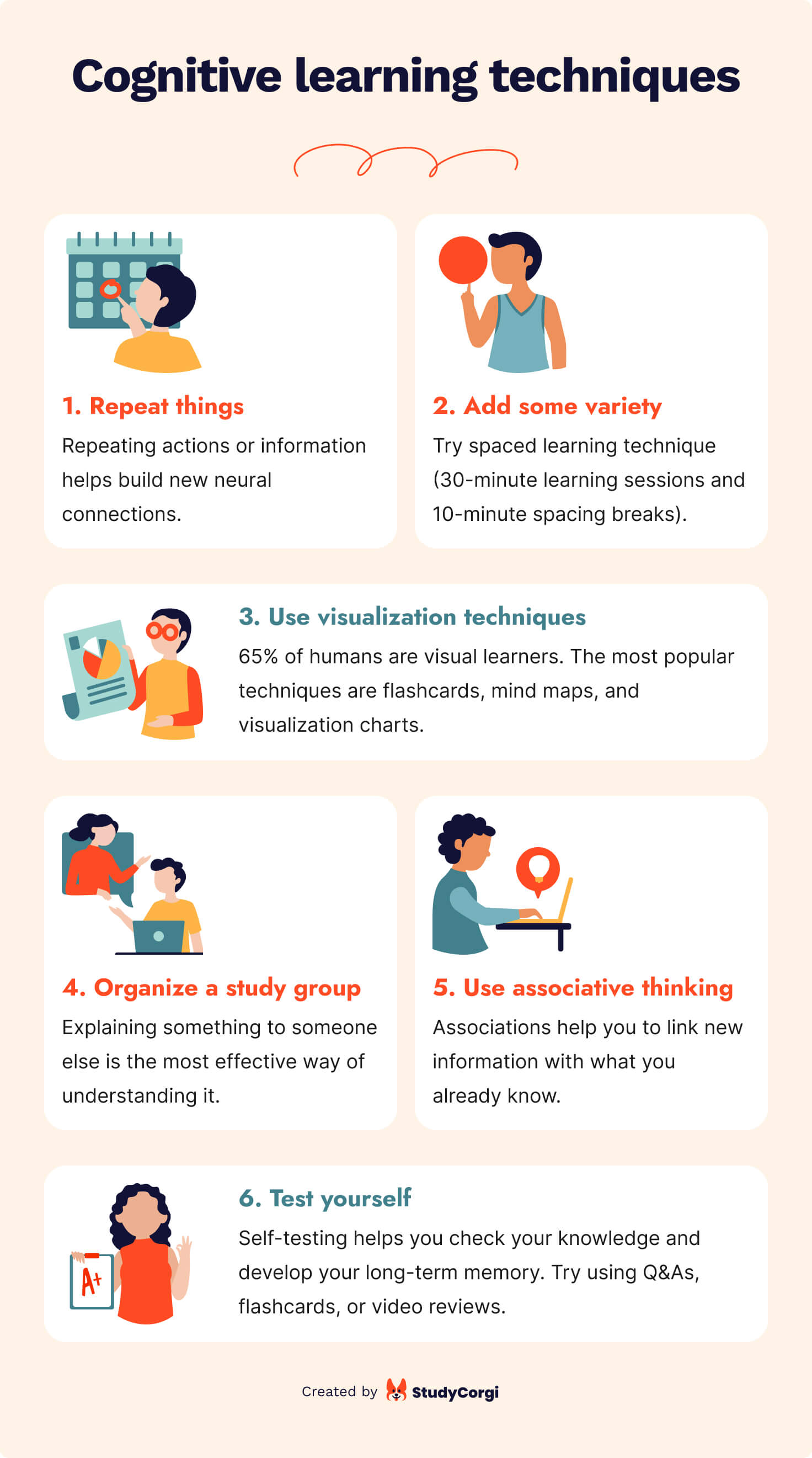
Repeat Things
Repetition is a vital strategy for implementing successful cognitive learning. Repeating actions or information helps build new neural connections.
By repeating information, students retain it in their memories for longer periods of time and more accurately because they clearly understand the concepts.
This tactic borrows heavily from the studies of a German psychologist, Hermann Ebbinghaus, who pioneered memory experiments in 1885. He claimed that regular repetitions are necessary under normal circumstances to enable accurate content reproduction, using poem reciting and discourse exercises to prove his suggestions.
Add Some Variety
Variety is another pillar in effective learning because the human mind hates monotony. Pursuing diversity is a great way to make the learning process more interesting.
For instance:
Teachers can shorten their explanations and punctuate them with organized physical workouts to achieve better outcomes regarding student comprehension.
Spaced learning is also an effective technique that boosts learning outcomes. It includes intense learning sessions that do not exceed 30 minutes at a time. Instructors may include three 10-minute spacing breaks into classes to achieve better memorization effects.
For example:
- The initial session might be a video or an instructor could make slide presentations that learners watch without taking notes.
- The second period might feature recalling information using quizzes.
- The third one could include information application by solving a problem or performing a task.
- During the breaks, learners can engage in distracting activities, such as memorizing random word lists irrelevant to the topic or physical workouts.
Using these approaches yields better learning results. Additionally, it doesn’t pressure learners to engage in cramming, a typical problem of traditional unspaced learning sessions. Instead, learners focus on understanding and internalizing what they hear or see instead of cramming.
Use Visualization Techniques
Many people learn better by sight than by hearing. No wonder 65% of humans are visual learners.
Instructors can use visualization techniques to instill knowledge, as discussed in the examples below.
You can use these visual tools for studying different subjects.
For instance:
- In math, they enable learners to understand concepts by creating a problem’s mental images.
- In literature, they create characters’ mental pictures and scenes.
- In natural science, they reveal the inner workings of different elements, for instance, cells and molecules.
Consider Organizing a Study Group
Sometimes, explaining something to someone else is the best way of learning it. This technique helps students demonstrate and improve their grasp of the study topics.
So, how do you create a setting to explain ideas to others as a learning strategy? A study group is a great option.
Forming a study group is vital because it nurtures a collaborative learning environment. Besides exposing students to different learning strengths, such groups are socially rich and engaging. Their activities create a healthy cooperative environment where everyone learns from each other.
However, it’s prudent to consider the advantages and disadvantages of group learning before creating one.
The pros of this learning method are:
- Learning groups can boost your knowledge of a topic by exposing you to what your classmates know better than you.
- It’s one of the best tools for overcoming procrastination.
- It helps you to get better grades.
- A group enables you to sharpen your problem-solving skills.
- You gain valuable team experience.
- You have a platform to share your talents with classmates.
- It also helps you to expand your support system.
The cons include the following:
- You might surround yourself with very different people in terms of learning preferences, approaches, and values, which may hinder your learning process or self-expression.
- Unproductive teammates may hurt your productivity.
- You can’t personalize your learning.
- Your classmates might have similar educational gaps.
Turn on Your Associative Thinking
Associations are vital in your academic journey because they help you to link new information with what you already know.
You need to find a way to frame valuable information within a relatable example or context. Otherwise, it will remain too abstract and detached from your experience.
An excellent example is why people learn math in school. While many think of math as a dull and abstract subject, it has a variety of useful applications in life:
- Managing your finances and bills.
- Planning travel based on the times and distances from your home to the destination.
- Cooking with the help of homemade recipes.
- Shopping around for the best deals in town.
- Repaying loans.
- Understanding the scores of your favorite sports team or board games.
By comprehending these real-life applications, students become more motivated to study. Thus, the core of any effective learning process is to show the benefits of new knowledge and its varied associations in real life scenarios.
Test Yourself
Lastly, you can apply self-testing, an effective learning tool that works well across the board. This practical method helps you check your knowledge and develop your long-term memory.
Self-testing is better than the traditional cramming approach that focuses on useless retrieval efficiency and fluency.
The latter method gives you a false sense of understanding. Unfortunately, all the information you cram fades with time because you don’t commit it to long-term memory.
Fortunately, self-testing is efficient and saves you the time you would waste cramming. Here are several examples of how to self-test your knowledge with little effort.
- Self-testing with Q&As. You can practice this technique by answering questions before checking multiple-choice options. Afterward, you can read the correct answers and explanations for enhanced understanding and correction.
- Using flashcards. You could also test yourself with flashcards. Think about everything you learned and generate the best answers. Afterward, read the flashcard’s flip side to confirm your accuracy.
- Using course or video review. Lastly, you can return response questions after watching video courses or reviews. Ensure you pause the video before the speaker answers the questions.
🏏 5 Tips to Improve Your Cognitive Function Outside the Classroom
Besides your personal study tactics, you can develop other beneficial habits to help you improve your cognitive power. These methods are effective, and you can apply them to enhance your life’s overall quality.
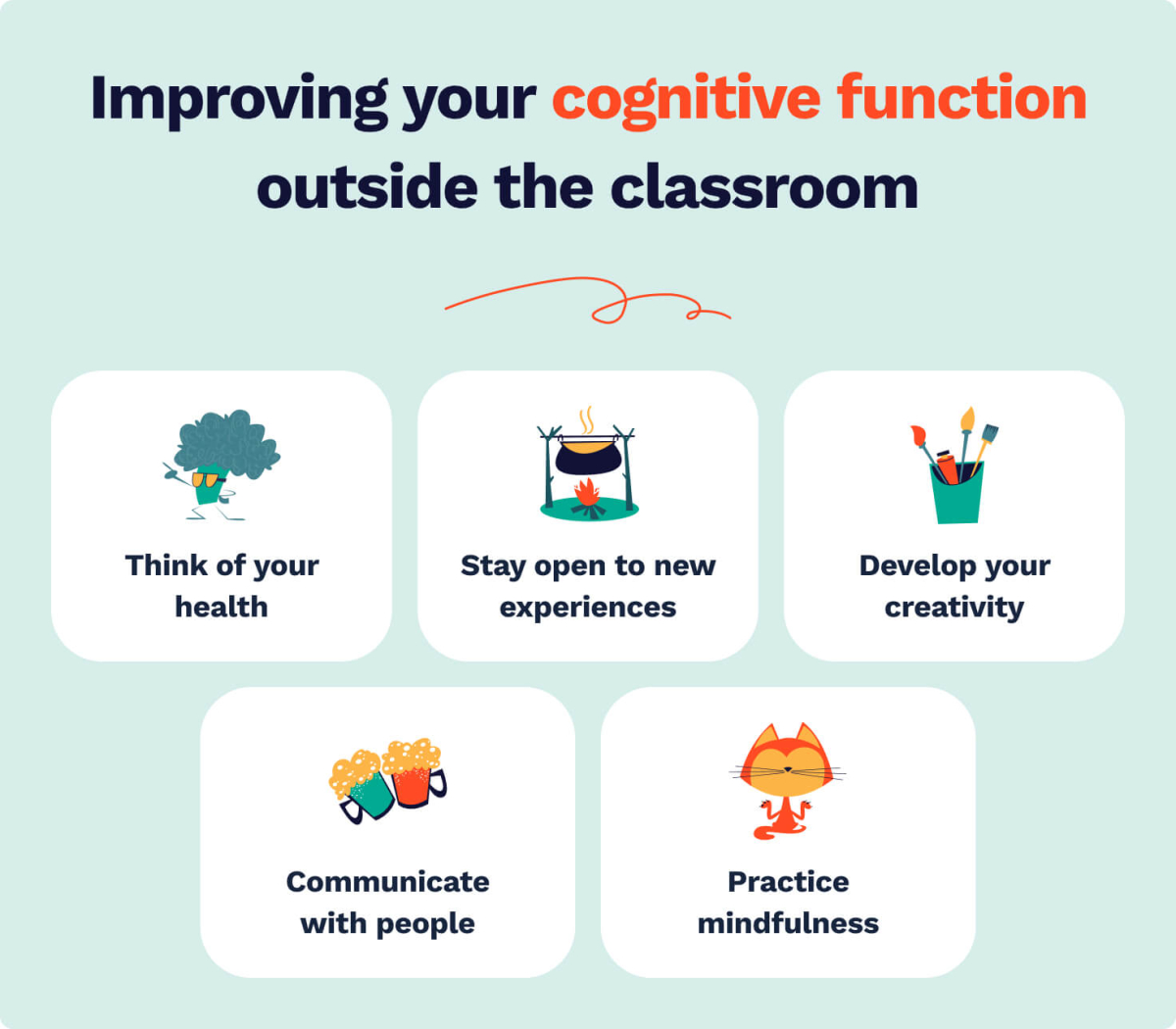
This section discusses the top 5 habits to help you boost your cognitive power outside the classroom.
Tip #1 – Think of Your Health
Your brain is an integral part of your body. Healthy living requires you to prioritize your lifestyle. Below are the three components to address when caring for your health.
Physical Activity
Physical activity is necessary for boosting your cognitive function. Optimizing your brain’s connectivity and maximizing new neural growth while sitting is nearly impossible. Thus, a quality workout improves your memory power by boosting certain hormones responsible for memory activation.
Healthy Food
Healthy eating is crucial for maintaining a sharp mind. But which foods can boost your brain power and keep it healthy?
Here are some valuable foods for the brain:
Sleep Hygiene
Lastly, sleeping well renews your brain cells for optimal function. It helps you to synchronize your body’s clock with your daily schedule.
The result?
Your productivity gets a boost. Inversely, upsetting your body’s biological clock makes you feel more tired and less productive.
Tip #2 – Stay Open to New Experiences
Opening yourself to new experiences is one way of boosting your mental power. Learning new data and mastering demanding skills in a social setting enables you to remain mentally sharp as you age.
The reason is that less demanding tasks, like completing a crossword puzzle, don’t significantly benefit an aging brain.
Challenging the brain with unfamiliar activities stretches and stimulates it to grow because staying in our comfort zone doesn’t promote growth.
Making a bucket list is an easy way of thinking about what you want to achieve in your lifetime. However, an impressive bucket list requires proper soul-searching before creating it. You don’t need to worry about it because you can adjust it as you age.
Additionally, you don’t need to itemize all your life goals; instead, just start with whatever crosses your mind and move forward. Remember, bucket list items can be experiential and active. This list is one way of revealing your life’s priorities.
Tip #3 – Develop Your Creativity
You can also boost your cognitive power by developing your creativity. Research has discovered that writing, engaging in brain-stimulating activities, and reading books boost your memory at any age. Science confirms that reading a novel stimulates people’s brains at various levels.
Below are 5 practical ways to boost your creative genius.
Tip #4 – Communicate with People
Getting social is another way of boosting your cognitive ability because loneliness is one of the leading causes of cognitive and physiological decline. Moreover, disconnecting yourself from others significantly disrupts sleep hygiene. In turn, poor sleeping patterns deny your brain the necessary rest to replenish worn-out cells and refresh.
Isolation also elevates blood pressure, which causes the following degenerative mental effects:
- Increased cortisol levels in the morning.
- Alteration in the immune cells’ gene expression.
- Increased depression.
- Reduced overall subjective wellness.
All these factors combined deny you the necessary mental health to be productive in life and class.
Tip #5 – Practice Mindfulness
You can also sharpen your cognitive skills by practicing mindfulness.
Try using these simple mindfulness techniques:
- Engage in mental body scanning
- Participate in mindful walking through the garden or park
- Practice mindful breathing by taking deep breaths
Meditation lets your brain unwind and frees up inner space for creative thinking and new knowledge assimilation. This way, your mind becomes better conditioned for productivity after successful meditation, thus boosting your focus.
Moreover, meditation can trigger stress reduction in the brain, significantly slowing age-related cognitive disorders like Alzheimer’s disease. Meditation also boosts your self-awareness and promotes sleep hygiene, which is critical for enhancing brain health and power.
Thank you for reading this article!
Cognitive learning is a vital tool for enforcing effective learning in all settings. While it might not necessarily pass as the ultimate learning method, it has many advantages over other approaches. We hope the valuable information in this guide will help you maximize its benefits for improved learning.
